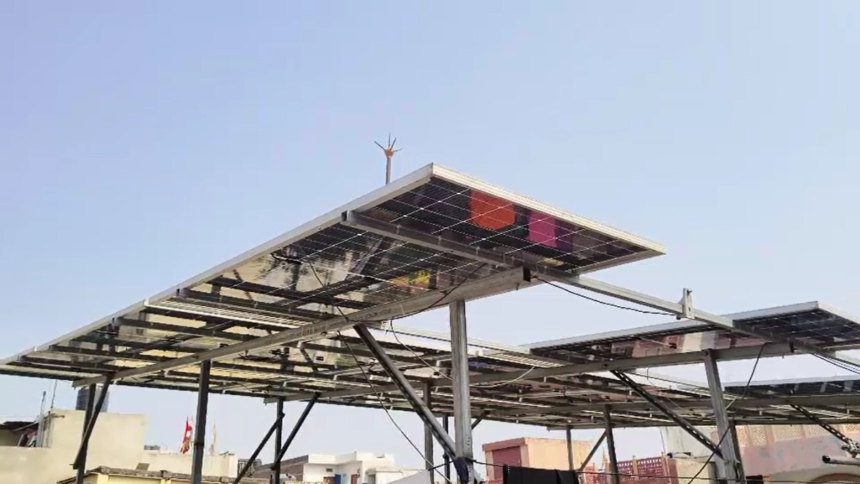Prime Minister Narendra Modi’s ambitious Prime Minister Surya Garh Yojana is bringing huge relief to residents across India through solar subsidies and installations. India Today TV brings you on-the-ground reports from Uttar Pradesh, Chhattisgarh, Rajasthan and Madhya Pradesh on how beneficiaries are utilizing rooftop solar panels for personal consumption and, in some cases, even generating a surplus The energy is sold back to others on the grid, creating new revenue streams.
India Today TV reporters visited consumers in Lucknow, Ghaziabad, Raipur, Jaipur and Indore.
uttar pradesh
In Uttar Pradesh, the government has set a target of installing 2.5 million solar panels in the next three years, and more than 43,000 installations have been completed so far.
In Lucknow, beneficiaries such as Prakash Mishra and Uday Pratap Singh shared their experiences. Mishra, who works in an Indian bank, installed a 4-kilowatt solar system at a cost of 2.38 lakh rupees, with a subsidy return of 1.08 rupees. The panel meets his daily energy needs and slashes his electricity bill.
“My consumption before and now is the same, but before I had to pay Rs 6,000 to Rs 7,000 during peak summer season, now I have to pay up to Rs 2,000,” Mishra said.
After installing a similar system, Uday Pratap Singh saw his monthly electricity bill reduced by Rs 3,500 during peak summer demand. He spent Rs 240,000 installing solar panels and received a subsidy of Rs 108,000.
“For a family of four, a 4-kilowatt solar panel is enough,” said Uday Pratap Singh. “In April, I installed this and by the end of May, I got subsidy from the state and central government. I didn’t have to call anyone to get the subsidy. The power department also gave full support.
Surendra, a teacher, installed a 3-kilowatt solar panel at a cost of 1.80 lakh rupees and received a subsidy of 1.08 lakh rupees.
“In this weather, it can generate 11-12 units and if the weather is fine, it can generate 16-18 units. There are many benefits of doing this. I can save Rs 2,500 to Rs 3,000 every month,” Surendra said.
The city’s solar business is also booming. Solar entrepreneur Ravi Pratap Singh reports a surge in demand, with about 25 panels being installed daily and more than 30 people employed. He attributed the growth to Prime Minister Narendra Modi’s solar promotion campaign.
“This is a big step towards Aatmanirbhar Bharat,” Pratap Singh said.
Elaborating on the installation process, he said, “The customer requires an electricity connection and a shadow-free space where the solar panels can be installed. The consumer requires basic documents like Aadhar card, electricity bill, etc. Then we register the consumer on the central government website. On the site, we get immediate approval for 1-10 kW installation. Once approved, we install the solar panels and any available distribution company in the area conducts a survey and prepares a report. The solar net meter is then installed there. Thereafter, within 30-45 days, customers can avail subsidies from the state and central governments.
“The installation of solar panels takes up to a week and the entire process of installing solar net meters takes 20-30 days,” says Ravi Pratap Singh, giving the process rough timetable.
Lokendra Vikram Singh entered the solar panel business in 2022 after seeing the interest in renewable energy. “Customers expect us to guarantee service and that their money will not be wasted,” Vikram Singh said.
Lokendra Vikram Singh said, We provide customers with a five-year service support plan that includes maintenance and cleaning guidelines for the panels. “While registering under the PM Solar Home scheme, the consumer’s electricity bill, email, mobile number, scrapped cheques, passbook and Aadhaar will be collected,” he said.
He praised the government for promoting the scheme and subsidies for renewable energy and attracting new customers.
When asked about the consumption pattern, Vikram Singh said, “In summer, consumption is more, but due to fine weather, production is also more. In winter, due to weather influence, production is reduced, but consumption also decreases.
In Ghaziabad, chief development officer Abhinav Gopal said more than 5,000 residents have joined the scheme. The government is targeting 2 lakh potential consumers to promote the scheme through banners, Gram Panchayat and community meetings. As a result, 10 industrial connections have been secured. The initiative is also disseminated through panchayats to maximize impact.
“I am sure that by next year we will be able to achieve the target of 200,000 consumers,” Abhinav Gopal said.
Talking about the advantages of installing solar panels, Gopal said, “The basic concept is that there is no storage space in the system. Whatever electricity is generated, it is fed into the grid. The electricity bill is minus the electricity generated. If you generate more For electricity, the balance can be deducted from next month’s bill, and maybe eventually your electricity bill could drop to zero.
Consumers who have installed these solar panels have shared their positive experiences.
For example, Kedaar Singh installed a 5 kW solar panel system and found it to be very cost-effective. He applied online but mentioned that he could also submit his application through UPNEDA (Uttar Pradesh New and Renewable Energy Development Agency).
Inspired by these benefits, his neighbor Ashutosh Bharadwaj is now also planning to install solar panels, believing that this is the best way to utilize the roof and make the most of solar energy.
“This is a visionary project, and the best way to use it is to put it on our roofs,” Bharadwaj said, standing under the solar panels.
Another consumer Dr OP Agarwal installed a 7 KW solar panel on his roof and reported a significant reduction in his electricity bills, calling the scheme a very beneficial government initiative. According to Agarwal, the installation process is quick, usually completed within 15 days of application and investigation.
Meanwhile, Ramesh, who has already installed a 12 kW system, noted that his system is not yet fully operational due to supplier delays. He said that under the scheme, systems with power up to 6 kW can get a subsidy of Rs 1.08 lakh, while with a dual-panel setup, he will get a subsidy of Rs 2.16 lakh.
madhya pradesh
Indore has also seen a surge in solar power installations as Prime Minister Narendra Modi pushes for solar power.
Indore Collector Ashish Singh said they are following government directives to install solar power in rural homes and ensuring that all city government buildings are equipped with solar systems.
Residents who have installed solar systems find this measure beneficial as they shift their focus from current expenses to long-term savings.
Indore businessman Dhananjay Pandey said that inspired by the Prime Minister’s call, he installed solar panels at his home and business and saved a lot of money. Pandey said a 3-kilowatt home solar system costs about Rs 1.80 lakh, with a government subsidy of Rs 78,000, bringing the net cost down to Rs 1 lakh. The investment will pay for itself within 4-5 years, and the solar panel company offers a 25-year warranty. This means that after the initial investment is recovered, consumers can enjoy free electricity for up to 20 years.
rajasthan
Many residents of Jaipur have significantly reduced the burden of high electricity bills by installing solar panels on their rooftops. People who once faced power bills worth thousands of dollars a month have now dropped to zero for many. In addition, some households have even begun to earn monthly income by selling the excess energy generated by the panels. Motivated by these results, more and more people are applying to join the scheme, eager to escape the financial burden of rising electricity bills.
In Ram Nagar, Jaipur, resident Rajeev Sain shared his experience. He applied through an organization in October 2023, and by April 2024, his solar panels were installed. Although the process took about six months, he encountered few problems. His 10-kilowatt solar panel system now produces about 50 units of electricity per day. He used 25 units for his personal needs and sold the remaining 25 units back to the government at about Rs 3 per unit. Earlier he paid about Rs 8,000 per month for electricity, but now he does not have to pay anything. The total cost of his 10 kW installation was Rs 5.25 lakh, of which Rs 1.17 lakh was subsidy.
“I recommend that everyone install solar panels to save money on their electricity bills,” Thain said.
Ram Babu Sharma of Kataria Colony also benefited from the scheme. Initially, he installed an 8-kilowatt solar panel system in 2022 at a cost of about Rs 3.5 lakh. The process was streamlined and handled by the agency, with little involvement from him. With the system in place, his monthly bills dropped from Rs 25,000 to Rs 30,000 to around Rs 10,000. Recently, he added an additional 2-kilowatt panel for Rs 1 lakh, further reducing the monthly bill to about Rs 3,000. He hopes to see that number get to zero soon. Sharma praised the program’s smooth application process, noting that the company handled most of the paperwork, minimizing the need for repeated follow-ups.
Mahendra Kumar Garg of Nandpuri installed a 5 kW system through a supplier in 2019 at a cost of about Rs 2 lakh with a subsidy of Rs 67,000.
“The system generates 20 units per day, which has significantly reduced his electricity bill. Apart from saving money, the solar panels also help reduce pollution. I can also generate excess electricity by selling it to the government at Rs 2.40 per unit. Earn extra income.
As many residents benefit from solar power, others in the community are inspired to follow suit. Neighbor Ankit observed the advantages enjoyed by his peers – lower electricity bills, one-time subsidies and the ability to sell power back to the grid. As the monthly electricity bill exceeds Rs 5,000, he recently applied for the installation of solar panels. He’s optimistic about the process and hopes the electricity bill will be eliminated soon.
chhattisgarh
In Chhattisgarh’s Raipur, more than 1,600 units were installed and users’ electricity bills dropped sharply.
In an interview with India Today TV, Suresh Agarwal praised its simple installation process and quick payment of subsidies.
“I consulted a company and learned that the installation was a simple process. The process started in June and was completed by the first week of July. By the second week of July, my entire system was updated. August 2 , after the solar system was completed and started, the subsidy was credited to my account by the end of the month,” said Suresh Agarwal.
He found that his monthly bill dropped from Rs 8,000 to just Rs 200.
Another consumer, Dr. Nageshwar Rao, said that he installed 5KW solar panels and his current electricity bill is negative. He is very optimistic about the future.
“The vendor made the process very smooth and easy. I didn’t even need to step out of my house to do the paperwork. From approval to installation to crediting of subsidy, everything was quick,” said Dr. Nageshwar Rao.
Smooth document preparation and subsidy deposit processes have boosted the scheme’s popularity, locals say.

